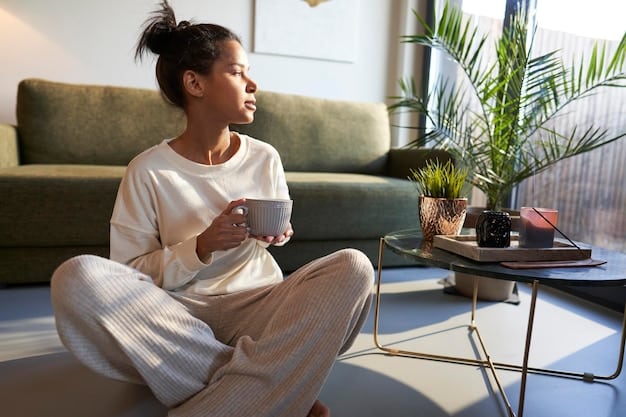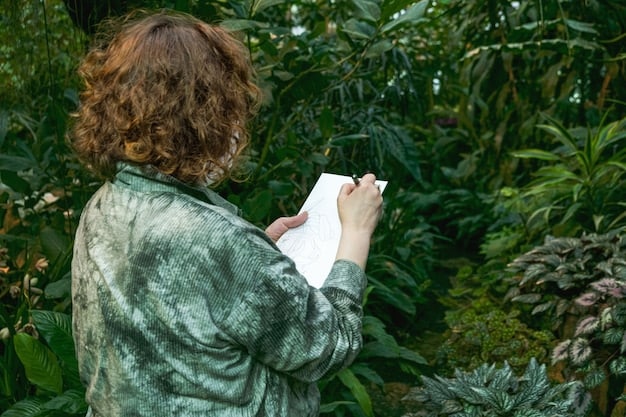Mental Wellness Toolkit: Essential Resources & How to Build Yours

A mental wellness toolkit is a personalized collection of resources and strategies that helps you manage your mental health, reduce stress, and enhance overall well-being, including techniques like mindfulness, journaling, and physical activities.
Discover how to create your own mental wellness toolkit, packed with essential resources and strategies to proactively manage your mental health and enhance your overall well-being. Taking charge of your mental health is a vital step towards a more balanced and fulfilling life.
Understanding the Importance of a Mental Wellness Toolkit
A mental wellness toolkit is not just a collection of random items; it’s a carefully curated set of resources designed to help you navigate the ups and downs of life and maintain a healthy mental state. It’s like having a personal first-aid kit for your mind.
Think of your mental wellness toolkit as a toolbox filled with strategies, techniques, and resources that you can use to address various mental and emotional challenges. It’s a proactive approach to self-care that empowers you to take control of your well-being.
Why Build a Mental Wellness Toolkit?
Building a mental wellness toolkit offers numerous benefits that contribute to your overall well-being. It provides you with:
- Increased Self-Awareness: By identifying what helps you cope and thrive, you gain a deeper understanding of your emotional needs.
- Improved Coping Skills: The toolkit equips you with practical strategies to manage stress, anxiety, and other mental health challenges.
- Enhanced Resilience: Having readily available resources helps you bounce back from setbacks and maintain a positive outlook.
- Greater Sense of Control: Taking proactive steps to manage your mental health empowers you to feel more in charge of your life.
Creating a mental wellness toolkit is an investment in yourself, providing you with the tools and knowledge to navigate life’s challenges with greater ease and resilience. It’s a personalized approach to self-care that can significantly improve your overall quality of life.

Identifying Your Mental Wellness Needs
Before you start filling your mental wellness toolkit, it’s important to understand your unique needs and challenges. What are your triggers? What activities help you feel calm and grounded? Identifying these factors will help you tailor your toolkit to your specific requirements.
Start by reflecting on your past experiences. What situations or events have caused you stress, anxiety, or sadness? What strategies have you used to cope with these feelings? Understanding your personal patterns can provide valuable insights into what resources would be most beneficial for you.
Reflecting on Past Experiences
Consider journaling about your experiences. Writing down your thoughts and feelings can help you identify recurring themes and triggers. Ask yourself:
- What are my common stressors?
- What activities do I find relaxing or enjoyable?
- What coping mechanisms have worked for me in the past?
- What are my warning signs of mental distress?
By answering these questions, you’ll gain a clearer understanding of your mental wellness needs and be better equipped to select resources for your toolkit that effectively address your specific challenges. Remember, this is a personal journey, and there’s no one-size-fits-all solution.
Essential Components of a Mental Wellness Toolkit
Now that you have a better understanding of your mental wellness needs, let’s explore some essential components that you can include in your toolkit. These resources can be categorized into different areas, such as relaxation techniques, coping strategies, and self-care activities.
The key is to select resources that resonate with you and that you’re likely to use regularly. Don’t feel pressured to include everything; start with a few essentials and gradually expand your toolkit as you discover what works best for you.
Relaxation Techniques
Relaxation techniques are essential for managing stress and anxiety. Some popular options include:
- Deep Breathing Exercises: Simple yet effective, deep breathing can calm your nervous system and reduce feelings of tension.
- Progressive Muscle Relaxation: This technique involves tensing and releasing different muscle groups to promote relaxation.
- Guided Meditation: Listening to guided meditations can help you focus your mind and cultivate a sense of inner peace.
Experiment with different relaxation techniques and find the ones that help you feel most calm and centered. Include these techniques in your toolkit and make them a regular part of your self-care routine.
Incorporating Mindfulness and Meditation
Mindfulness and meditation are powerful tools for enhancing mental well-being. They involve focusing your attention on the present moment without judgment. This practice can help you become more aware of your thoughts and emotions, reduce stress, and cultivate a sense of inner peace.
There are many different types of mindfulness and meditation practices, so it’s important to find one that resonates with you. You can try:
Different Types of Mindfulness and Meditation
- Mindful Breathing: Simply focusing on your breath can help you anchor yourself in the present moment.
- Body Scan Meditation: This involves bringing awareness to different parts of your body, noticing any sensations without judgment.
- Walking Meditation: Paying attention to the sensations of walking can be a grounding and calming experience.
- Loving-Kindness Meditation: Focusing on compassion and sending well wishes to yourself and others can cultivate feelings of connection and kindness.

The Power of Journaling and Creative Expression
Journaling can be a powerful tool for self-reflection, emotional processing, and stress management. It provides a safe space to explore your thoughts and feelings without judgment. Creative expression, such as painting, drawing, or writing poetry, can also be a cathartic and healing experience.
Consider including journaling and creative expression in your mental wellness toolkit. You can use journaling prompts to guide your reflections or simply write freely about whatever comes to mind. Experiment with different creative outlets to discover what helps you express yourself and process your emotions.
Journaling Prompts to Spark Reflection
- What are you grateful for today?
- What challenges are you facing, and how can you approach them with resilience?
- What are your strengths and accomplishments?
- What are your goals, and what steps can you take to achieve them?
By incorporating journaling and creative expression into your toolkit, you can tap into your inner resources and gain a deeper understanding of yourself. These practices can help you process emotions, reduce stress, and cultivate a greater sense of self-awareness.
Building a Supportive Social Network
Social connection is essential for mental well-being. Having a supportive network of friends, family, or community members can provide a sense of belonging, reduce feelings of isolation, and offer emotional support during challenging times.
Make a list of people you trust and feel comfortable talking to. These could be friends, family members, therapists, or members of support groups. Reach out to these individuals when you need to talk, connect, or simply share your experiences.
Connecting with Others
Consider these strategies that will help you connect with people and will boost your mental health:
- Join a support group: Connecting with others who share similar experiences can provide validation, understanding, and a sense of community.
- Volunteer: Helping others can boost your mood and provide a sense of purpose.
- Engage in social activities: Participating in hobbies, clubs, or events can help you meet new people and build relationships.
Nurturing your social connections is an important aspect of a mental wellness toolkit. By building a supportive network, you’ll have a reliable source of support and connection during both good times and bad.
| Key Point | Brief Description |
|---|---|
| 🧘 Relaxation Techniques | Use deep breathing, meditation, or progressive muscle relaxation to calm your mind and body. |
| ✍️ Journaling | Reflect on experiences, emotions, and gratitudes. Use prompts to guide reflection or freely write about thoughts. |
| 💪 Physical Activity | Engage in regular exercise like walking, yoga, or any enjoyable movement to reduce stress. |
| 🤝 Social Connection | Connect with loved ones, join support groups, and nurture relationships for emotional support. |
Frequently Asked Questions
▼
A mental wellness toolkit is a collection of strategies and resources you can use to support your mental health. It’s tailored to your personal needs and preferences, helping you manage stress and improve your well-being.
▼
Creating a mental wellness toolkit can help you proactively manage stress, improve coping skills, and enhance your overall mental health. It empowers you to take control of your well-being and respond effectively to challenges.
▼
Essential items include relaxation techniques, mindfulness practices, journaling prompts, grounding exercises, and a list of supportive social contacts. Customize your toolkit based on what you find most helpful.
▼
Use your toolkit as often as needed. It’s helpful to use it regularly, even when you’re feeling well, to maintain your mental health. Use more frequently during stressful times or when you notice warning signs of mental distress.
▼
Explore online resources, mental health apps, books, and local community centers for ideas. Talk to a therapist or counselor for personalized recommendations on what to include in your toolkit.
Conclusion
Creating a mental wellness toolkit is a proactive and empowering step towards managing your mental health. By carefully selecting resources and strategies that resonate with you, you can build a personalized toolkit that supports your well-being and helps you navigate life’s challenges with greater resilience and ease. Remember to revisit and update your toolkit regularly to ensure it continues to meet your evolving needs.





